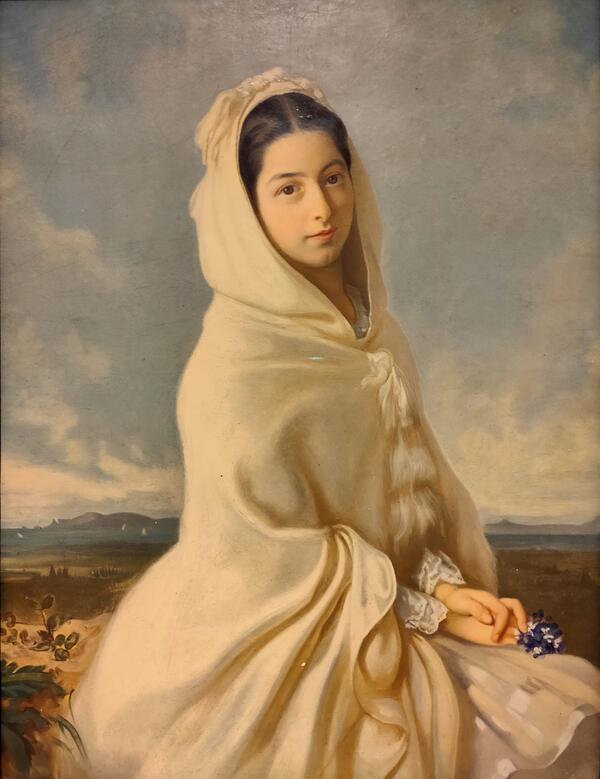Pyotr Zakharov-Chechenets painted a portrait of Ekaterina Arkadyevna Stolypina in the 1840s. He depicted a girl sitting half-turned to the viewer. She is dressed in a flowing white cape with a hood tied over her hair. She is holding a small bouquet of flowers. The author chose a steppe landscape as a background — he emphasized the romantic appearance of the girl.
The motive of open nature is one of the features of romanticism. Romanticists were attracted by strong passions and elements, large-scale mountain and steppe distances. In romantic portraits, artists often used landscape backgrounds to deepen the image. Also, romantic artists sought to bring out the special traits of each central character, to capture the strong feelings of their models. Pyotr Zakharov-Chechenets created a romantic portrait: he managed to convey the free, proud character of Ekaterina Stolypina and the depth of her large, attentive eyes.
This portrait has long been listed in catalogs as ‘Portrait of V.A. Goltseva’ by an unknown artist. But in 2018, art critic Meda Shakhbieva turned to the Museum of the Republic of Buryatia with a request to show her a photograph of this work. The fact is that in state archives, she found a lithograph from the Dmitrov Kremlin Museum-Reserve with a similar figure. The central figure of the lithograph was called Ekaterina Stolypina, and the work itself was signed by Pyotr Zakharov-Chechenets. An employee of the Museum of the Republic of Buryatia and Meda Shakhbieva compared the two portraits and found that they were identical. So the audience learned that the romantic girl is one of the daughters of Arkady Stolypin, and that this painting was painted by an outstanding artist of the 19th century.
Pyotr Zakharov was the only professional artist of Chechen origin in the 19th century. It is believed that his fate inspired Mikhail Lermontov to create the poem ‘Mtsyri’. During the Caucasian War in 1819, as a boy he was found by soldiers near the body of his deceased mother — she did not survive the battle near the Chechen village of Dadi-Yurt. The child was taken with them and named Pyotr. He received his surname and patronymic from the soldier Zakhar Nedonosov, who took care of him. Later the baby was brought up by Pyotr Ermolov, a cousin of General Alexei Ermolov. Pyotr Ermolov was attentive to his adopted son: he noticed the boy’s talent and did everything to get him as an unenrolled student in the Academy of Arts.
Pyotr Zakharov-Chechenets quickly made a name for himself. Many famous people posed for him. The artist never forgot his origins. He signed his works “Zakharov-Chechenets”, “Zakharov-Dada-Yurtsky”, “Zakharov from Chechens”, “Chechen from Dada-Yurt”. The master lived only 30 years: at the end of the summer of 1846, he died of consumption. But even for such a short life, he managed to become famous as a talented portrait painter.
The motive of open nature is one of the features of romanticism. Romanticists were attracted by strong passions and elements, large-scale mountain and steppe distances. In romantic portraits, artists often used landscape backgrounds to deepen the image. Also, romantic artists sought to bring out the special traits of each central character, to capture the strong feelings of their models. Pyotr Zakharov-Chechenets created a romantic portrait: he managed to convey the free, proud character of Ekaterina Stolypina and the depth of her large, attentive eyes.
This portrait has long been listed in catalogs as ‘Portrait of V.A. Goltseva’ by an unknown artist. But in 2018, art critic Meda Shakhbieva turned to the Museum of the Republic of Buryatia with a request to show her a photograph of this work. The fact is that in state archives, she found a lithograph from the Dmitrov Kremlin Museum-Reserve with a similar figure. The central figure of the lithograph was called Ekaterina Stolypina, and the work itself was signed by Pyotr Zakharov-Chechenets. An employee of the Museum of the Republic of Buryatia and Meda Shakhbieva compared the two portraits and found that they were identical. So the audience learned that the romantic girl is one of the daughters of Arkady Stolypin, and that this painting was painted by an outstanding artist of the 19th century.
Pyotr Zakharov was the only professional artist of Chechen origin in the 19th century. It is believed that his fate inspired Mikhail Lermontov to create the poem ‘Mtsyri’. During the Caucasian War in 1819, as a boy he was found by soldiers near the body of his deceased mother — she did not survive the battle near the Chechen village of Dadi-Yurt. The child was taken with them and named Pyotr. He received his surname and patronymic from the soldier Zakhar Nedonosov, who took care of him. Later the baby was brought up by Pyotr Ermolov, a cousin of General Alexei Ermolov. Pyotr Ermolov was attentive to his adopted son: he noticed the boy’s talent and did everything to get him as an unenrolled student in the Academy of Arts.
Pyotr Zakharov-Chechenets quickly made a name for himself. Many famous people posed for him. The artist never forgot his origins. He signed his works “Zakharov-Chechenets”, “Zakharov-Dada-Yurtsky”, “Zakharov from Chechens”, “Chechen from Dada-Yurt”. The master lived only 30 years: at the end of the summer of 1846, he died of consumption. But even for such a short life, he managed to become famous as a talented portrait painter.



